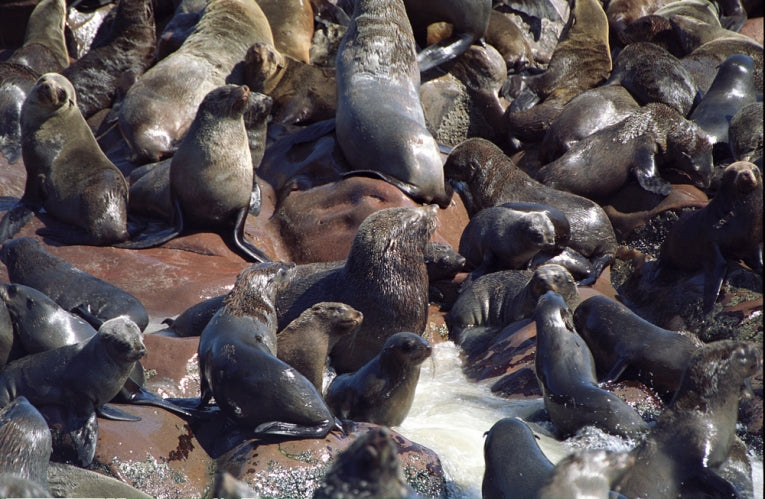"However gruesome the methods used to club sounds, the killing of pups is the 'most practical and the only one applicable' in Namibia. A club strike on the head of a pup (although it may appear brutal) is humane if it achieves rapid, irreversible loss of consciousness and leading to death", the words of the Namibian Ombudsman, John Walters, as quoted in the 'The Namibian' (26 June 2012), in delivering his decision on seal culling in Namibia.
A pup in any species is a baby, this being a fellow mammal, all I can imagine is this barbaric illogic being used to justify any over-population of any one species, including our own, after all we are the most overpopulated species in the animal kingdom, not only destroying the planet but draining all natural resources unfairly and are not open to the laws of nature, we have no other animal predators, we lock them all up and take away their wild habitats.
I've been an emotional water-fountain through all the video footage on the actual cull acts, the seals twitch with life, and the torturers head-back with an obvious zeal to again brutally club the obviously alive, in-pain seals over the head repeatedly, so much for Walters' "humane" club-culling. Seeing nursing babies as young as 7 months being cruelly battered to death in any life-form is a heartless tragedy.
This week marks the start of Namibia's annual seal cull, which lasts till November. This year's death targets are estimated at 85,000 pups and 6,000 bulls. According to the Sea Shepherd, an ocean species protection vessel, "baby seal pups are clubbed, then often alive when stabbed in the heart and skinned. Clubbing begins when the seal pups are just seven months old, still little babies, and very much dependent on their mothers. Both Canada and Russia stopped and banned the practice of killing seal pups still nursing or less than one year of age. The European Union (EU) last year banned all imports of seal products due to cruelty. Total import bans on all seal products are now also in effect in the US, Mexico and South Africa - for a total of 27 countries."
Unveiling Fur and Body Part Trade
The cullers argue that they are controlling overpopulation of the seals, just watching them engaging in clubbing, when euthanized options exist without brutal violence. But that entire overpopulation argument is an obverse one to keep an entire industry shrouded, the industry of seal pelt trade, beauty product component trade, and body part trading. Omega 2 oil is also extracted from the seals, and their meat used in animal feed, the blood-economics of culling. Exactly, these battered seals are killed for human profit. Asia being a key market for selling off the male seal sexual organs as an aphrodisiac. Yet again another species lost to blood trade, the rhinos, lions, seals and countless other species. The cullers all get away legally with protectors like so-called objective ombudspersons passing public myopia widely and with legal clout.
Seal-processing plants in Namibia
The Cape Seals are hunted commercially off the Skeleton Coast. The killings take place within two reserves, Cape Cross and Wolf-Atlas Bay, where 75% (Sea Shepherd, 2012) of the pups are born. The seals are entrapped and then battered to death with spiked clubs.
Namibian Seal Trade King-Pin
A monopoly exists on the Namibian culling industry, with Hatem Yavuz, a Turkish-Australian, having a long-term contract with Namibia to purchase all the fur at a meagre $3 with a resale value of $30,000 (Sea Sherpherd, 2012). Yavuz is in collaboration with the local cullers, who own the two seal plants in Namibia. Yavuz went so far in 2009 in proposing that if the animal rights activists wanted to stop the culling and seal trade, they should consider buying him and his partners out at $14.25 million (The National, 2009). Why should blood-operators be allowed to exhort money from conscience citizens engaged in promoting a better humanity and ending brutality to all species? Governments should end this practice with outright bans and remove themselves from what is a farce of claiming seal-overfishing when all it is, is profit made on sadistic batterings. While the seals are being battered under the guise of overfishing, what of all the illegal overfishing and huge impacts caused by trawlers to the oceanic ecosystem?
Other cullers are Canada, Iceland, Norway, Sweden, Finland and Greenland. The European ban on the Cape Seal fur is one step, however the Namibian government's haughty response that the EU ban wouldn't affect them as they have other markets, is the point, all avenues for trade must be halted with bans globally. No demand, no supply! Of course, black market trade and poaching is bound to occur, but that's where state enforcement and vigilant policing comes in. If citizens groups take such an active role in protecting the planet, paid government officials have a duty.
Least of the utter illogical statements made by the Namibian ombudsperson was the one that seal culling has been happening for centuries. Well does his logic apply to the slave trade? Just because something inhumane was practised for ages that is no justification for its continuation.
Editor Note: We have been informed that the fur seal pup image used first was several months too young to be one of those killed in the cull; we have therefore updated the image with a fur seal colony. PR
Watch the videos:










